NASA Administrator Sean O’Keefe has announced that he will be asking the US Congress to approve up to $1.6 billion to send a robotic mission up to the Hubble Space Telescope to make repairs and keep it operational for many more years. He said that he was “actually astonished” at the progress that NASA engineers have been making with a robotic solution. NASA still has no plans to send a human mission to the telescope, but they could know within six months if the budget for a robotic mission gets approved.
Hubble Instrument Fails
One of four science instruments aboard NASA’s Hubble’s Space Telescope suspended operations earlier this week, and engineers are now looking into possible recovery options.
The instrument, called the Space Telescope Imaging Spectrograph (STIS), was installed during the second Hubble servicing mission in 1997 and was designed to operate for five years. It has either met or exceeded all its scientific requirements.
Hubble’s other instruments, the Near Infrared Camera and Multi-Object Spectrometer (NICMOS), the Advanced Camera for Surveys, and the Wide Field/Planetary Camera 2 are all operating normally.
The STIS instrument, which went into a suspended mode Tuesday, was not slated for replacement or upgrade as part of any future servicing mission.
NASA has convened an Anomaly Review Board to investigate the cause of the STIS problem and an investigation is underway to determine if the instrument is recoverable.
Preliminary findings indicate a problem with the +5V DC-DC power converter on Side 2, which supplies power to the mechanism’s electronics. STIS suffered a similar electrical malfunction in 2001 that rendered Side 1 inoperable.
A final decision on how to proceed is expected in the coming weeks as analysis of the problem progresses.
In the current observing cycle, STIS accounts for about 30 percent of all Hubble scientific observation programs. A “standby” list of peer reviewed and approved observing programs for the other science instruments on Hubble can be used to fill the observing time now available.
The high sensitivity and spatial resolution of STIS enabled astronomers to search for massive black holes and study star formation, planets, nebulae, galaxies, and other objects in fine detail.
STIS was developed jointly with Ball Aerospace under the direction of principal investigator Dr. Bruce E. Woodgate of the Laboratory for Astronomy and Solar Physics at NASA’s Goddard Space Flight Center, Greenbelt, Md.
Among the major scientific achievements made by scientists using STIS were:
? Independent confirmation of the age of the universe by finding the coolest and hence oldest white dwarf stars that exist in our galaxy
? Conducted an efficient census of galaxies to catalog supermassive black holes. The fraction of galaxies that prove to contain a central massive black hole has proven to be surprisingly large
– Made the first-ever measurements of the chemical composition of the atmosphere of an extrasolar planet
– Saw the magnetic “footprints” of the Jovian satellites in Jupiter aurora, and made clear images of Saturn’s aurora
– Studied the dynamics of circumstellar disks, the region around young stars where planets may form
– Found the first evidence of the high-speed collision of gas in the recent supernova remnant SN1987A
Additional information about STIS is available on the Internet at:
http://hubble.nasa.gov/servicing-missions/sm2.html
Original Source: NASA News Release
Lagoon Nebula By Hubble
This NASA/ESA Hubble Space Telescope image reveals a pair of half a light-year long interstellar ‘twisters’, eerie twisted funnel structures, in the heart of the Lagoon Nebula (M8).
The central hot star, O Herschel 36 (shown here on left, red), is the primary source of the ionising radiation for the brightest region in the nebula, called the ‘Hourglass’. Other hot stars, also present in the nebula, are ionising the outer visible parts of the nebulous material.
This ionising radiation heats up and ‘evaporates’ the surfaces of the clouds (seen as a blue ‘mist’ at the right of the image), and drives violent stellar winds which tear into the cool clouds.
Analogous to the phenomena of tornadoes on Earth, the large difference in temperature between the hot surface and cold interior of the clouds, combined with the pressure of starlight, may produce strong horizontal ‘windshear’ to twist the clouds into their tornado-like appearance.
The Lagoon Nebula and nebulae in other galaxies are sites where new stars are being born from dusty molecular clouds. These regions are the ‘space laboratories’ for astronomers to study how stars form and the interactions between the winds from stars and the gas nearby. By studying the wealth of data revealed by Hubble, astronomers will understand better how stars form in the nebulae.
These colour-coded images are the combination of individual exposures taken in 1995 with Hubble’s Wide Field and Planetary Camera 2 (WFPC2).
Original Source: ESA News Release
Eclectic Group of Galaxies Captured by Hubble
Like a photographer clicking random snapshots of a crowd of people, NASA’s Hubble Space Telescope has taken a view of an eclectic mix of galaxies. In taking this picture, Hubble’s Advanced Camera for Surveys was not looking at any particular target. The camera was taking a picture of a typical patch of sky, while Hubble’s infrared camera was viewing a target in an adjacent galaxy-rich region.
The jumble of galaxies in this image, taken in September 2003, includes a yellow spiral whose arms have been stretched by a possible collision [lower right]; a young, blue galaxy [top] bursting with star birth; and several smaller, red galaxies.
But the most peculiar-looking galaxy of the bunch ? the dramatic blue arc in the center of the photo ? is actually an optical illusion. The blue arc is an image of a distant galaxy that has been smeared into the odd shape by a phenomenon called gravitational lensing. This “funhouse- mirror effect” occurs when light from a distant object is bent and stretched by the mass of an intervening object. In this case the gravitational lens, or intervening object, is a red elliptical galaxy nearly 6 billion light-years from Earth. The red color suggests that the galaxy contains older, cooler stars.
The distant object whose image is smeared into the long blue arc is about 10 billion light-years away. This ancient galaxy existed just a few billion years after the Big Bang, when the universe was about a quarter of its present age. The blue color indicates that the galaxy contains hot, young stars.
Gravitational lenses can be seen throughout the sky because the cosmos is crowded with galaxies. Light from distant galaxies, therefore, cannot always travel through space without another galaxy getting in the way. It is like walking through a crowded airport. In space, a faraway galaxy’s light will travel through a galaxy that is in the way. But if the galaxy is massive enough, its gravity will bend and distort the light.
Long arcs, such as the one in this image, are commonly seen in large clusters of galaxies because of their huge concentrations of mass. But they are not as common in isolated galaxies such as this one. For the gravitational lens to occur, the galaxies must be almost perfectly aligned with each other.
Gravitational lenses yield important information about galaxies. They are a unique and extremely useful way of directly determining the amount of mass, including dark matter, in a galaxy. Galaxies are not just made up of stars, gas, and dust. An invisible form of matter, called dark matter, makes up most of a galaxy’s mass. A study of this newly discovered system, dubbed J033238-275653, was published in the Astrophysical Journal Letters. This study, together with similar observations, may allow astronomers to make the first direct measurements of the masses of bright, nearby galaxies.
Original Source: Hubble News Release
New Details at the Heart of the Trifid Nebula
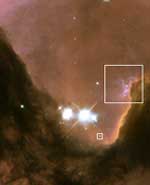
Image credit: Hubble
Three huge intersecting dark lanes of interstellar dust make the Trifid Nebula one of the most recognizable and striking star birth regions in the night sky. The dust, silhouetted against glowing gas and illuminated by starlight, cradles the bright stars at the heart of the Trifid Nebula. This nebula, also known as Messier 20 and NGC 6514, lies within our own Milky Way Galaxy about 9,000 light-years (2,700 parsecs) from Earth, in the constellation Sagittarius.
This new image from the Hubble Space Telescope offers a close-up view of the center of the Trifid Nebula, near the intersection of the dust bands, where a group of recently formed, massive, bright stars is easily visible. These stars, which astronomers classify as belonging to the hottest and bluest types of stars called type “O,” are releasing a flood of ultraviolet radiation that dramatically influences the structure and evolution of the surrounding nebula. Many astronomers studying nebulae like the Trifid are focusing their research on the ways that waves of star formation move through such regions.
The group of bright O-type stars at the center of the Trifid illuminates a dense pillar of gas and dust, seen to the right of the center of the image, producing a bright rim on the side facing the stars. At the upper left tip of this pillar, there is a complex filamentary structure. This wispy structure has a bluish color because it is made up of glowing oxygen gas that is evaporating into space.
Star formation is no longer occurring in the immediate vicinity of the conspicuous group of bright O-type stars, because their intense radiation has blown away the gas and dust from which stars are made. However, not far away there are signs of interstellar material collapsing under its own gravity, leading to ongoing star formation. One such example is a very young star that is still surrounded by a ring of gas and dust left over from the star’s formation. These circumstellar rings, called protoplanetary disks, or “proplyds” for short, are believed to be the locations where planetary systems are formed. A proplyd in the Trifid Nebula is visible near the lower right of the main Hubble image. An image enlargement of the proplyd is shown in the lower left box, where its elongated shape can be seen.
In the box at upper right, a jet of material is seen being ejected from a very young, low-mass star. The jet, extending to the lower right of the box, protrudes from the head of a dense pillar and extends three-quarters of a light-year out into the surrounding thin gas. The jet’s source is a very young stellar object that lies buried within the pillar. Previous Hubble images of the Trifid Nebula, taken in 1997, show very small, but noticeable changes in the knotty material being ejected from this jet. Accompanying the jet is a nearby stalk that points directly toward the central stars in the Trifid Nebula. This finger-like stalk is similar to the large pillars of gas in the well-known Eagle Nebula, also imaged by Hubble.
The Hubble image of the Trifid Nebula has given astronomers insight into the nature of the interaction of gaseous, dusty and stellar material in an area where dust, gas clouds, and new and old stars coexist. The science team, composed of Farhad Yusef-Zadeh (Northwestern U.), John Biretta (STScI), Bob O’Dell (Vanderbilt U.), and Mark Wardle (Macquarie U.), took exposures in filters that transmit light emitted by oxygen, hydrogen, and sulfur ions. The images were taken with the Wide Field Planetary Camera 2 onboard Hubble in mid-summer 2001 and 2002. This image was produced by the Hubble Heritage Team.
Original Source: Hubble News Release
NASA Considering Robotic Mission to Save Hubble

Image credit: University of Maryland
NASA Administrator Sean O’Keefe today announced the agency’s decision to pursue the feasibility of a robotic servicing mission to the Hubble Space Telescope (HST). NASA initiated the first step toward enabling such a mission with the release of a Request for Proposals today. The due date for proposal submissions is July 16, 2004.
“This is the first step in a long process of developing the best options to save Hubble,” Administrator O’Keefe said. “We are on a tight schedule to assure a Hubble servicing mission toward the end of calendar year 2007. But we must act promptly to fully explore this approach.”
Although the primary goal of a robotic mission is to install a deorbit module on the HST, NASA is studying the feasibility of performing other tasks. The tasks could include installing new batteries, gyros and possibly science instruments that would enhance the observatory’s ability to peer even more deeply into the universe. The final decision about specific robotic tasks will be made after all proposals have been thoroughly reviewed.
Original Source: NASA News Release
Hubble Looks at Sedna
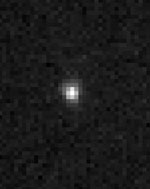
Image credit: Hubble
Astronomers poring over 35 NASA Hubble Space Telescope images of the solar system’s farthest known object, unofficially named Sedna, are surprised that the object does not appear to have a companion moon of any substantial size.
This unexpected result might offer new clues to the origin and evolution of objects on the far edge of the solar system.
When Sedna’s existence was announced on March 15, its discoverer, Mike Brown of Caltech, was so convinced it had a satellite that an artist’s concept of Sedna released to the media included a hypothetical moon.
Brown’s prediction was based on the fact that Sedna appears to have a very slow rotation that could best be explained by the gravitational tug of a companion object. Almost all other solitary bodies in the solar system complete a spin in a matter of hours.
“I’m completely baffled at the absence of a moon,” says Brown. “This is outside the realm of expectation and makes Sedna even more interesting. But I simply don’t know what it means.”
Immediately following the announcement of the discovery of Sedna, astronomers turned the Hubble Space Telescope toward the new planetoid to search for the expected companion moon. The space-based platform provides the resolving power needed to make such precision measurements in visible light. “Sedna’s image isn’t stable enough in ground-based telescopes,” says Brown.
Surprisingly, the Hubble images taken March 16 with the new Advanced Camera for Surveys only show the single object Sedna, along with a faint, very distant background star in the same field of view.
“Despite HST’s crisp view (equivalent to trying to see a soccer ball 900 miles away), it still cannot resolve the disk of mysterious Sedna,” says Brown. This would place an upper limit in the object’s size of being approximately three-quarters the diameter of Pluto, or about 1,000 miles across.
But Brown predicted that a satellite would pop up as a companion “dot” in Hubble’s precise view. The object is not there, though there is a very small chance it might have been behind Sedna or transiting in front of it, so that it could not be seen separately from Sedna itself in the Hubble images.
Brown based this prediction on his earlier observations of apparent periodic changes in light reflecting from Sedna’s mottled surface. The resulting light curve gives a long rotation period exceeding 20 days (but not greater than 50 days). If true, Sedna would be the slowest rotating object in the solar system after Mercury and Venus, whose slow rotation rates are due to the tidal influence of the Sun.
One easy way out of this dilemma is the possibility that the rotation period is not as slow as the astronomers thought. But even with a careful reanalysis the team remains convinced that the period is correct. Brown admits, “I’m completely lost for an explanation as to why the object rotates so slowly.”
Small bodies like asteroids and comets typically complete one rotation in a matter of hours. Pluto’s rotation has been slowed to a relatively leisurely six-day period because Pluto is tidally locked to the revolution period of its satellite Charon. Hubble easily resolves Pluto and Charon as two separate bodies. NASA’s forthcoming James Webb Space Telescope will provide a platform for further high-resolution studies of the infrared light from such distant, cold bodies in our solar system.
The Space Telescope Science Institute (STScI) is operated by the Association of Universities for Research in Astronomy, Inc. (AURA), for NASA, under contract with the Goddard Space Flight Center, Greenbelt, MD. The Hubble Space Telescope is a project of international cooperation between NASA and the European Space Agency (ESA).
Original Source: Hubble News Release
Hubble Peers Into the Heart of Galaxy NGC 300
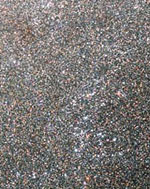
Image credit: Hubble
What appear as individual grains of sand on a beach in this image obtained with NASA’s Hubble Space Telescope are actually myriads of stars embedded deep in the heart of the nearby galaxy NGC 300. The Hubble telescope’s exquisite resolution enables it to see the stars as individual points of light, despite the fact that the galaxy is millions of light-years away.
NGC 300 is a spiral galaxy similar to our own Milky Way. It is a member of a nearby collection of galaxies known as the Sculptor group, named for the southern constellation where the group can be found. The distance to NGC 300 is 6.5 million light-years, making it one of the Milky Way’s closer neighbors. At this distance, only the brightest stars can be picked out from ground-based images. With a resolution some 10 times better than ground-based telescopes, Hubble’s Advanced Camera for Surveys (ACS) resolves many more stars in this galaxy than can be detected from the ground.
A ground-based Digitized Sky Survey image of the full field of NGC 300 is shown in the top left frame. An outline of the Hubble Heritage ACS image is marked and shown in the image in the top right frame. A detailed blowup of this image (in the bottom frame) shows individual stars in the galaxy. A background spiral galaxy is visible in the lower right corner. The individual Hubble ACS exposures were taken in July and September 2002.
Original Source: Hubble News Release
Hubble Helps Measure the Pace of Dark Energy
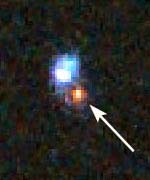
Image credit: Hubble
The good news from NASA’s Hubble Space Telescope is that Einstein was right ? maybe.
A strange form of energy called “dark energy” is looking a little more like the repulsive force that Einstein theorized in an attempt to balance the universe against its own gravity. Even if Einstein turns out to be wrong, the universe’s dark energy probably won’t destroy the universe any sooner than about 30 billion years from now, say Hubble researchers.
“Right now we’re about twice as confident than before that Einstein’s cosmological constant is real, or at least dark energy does not appear to be changing fast enough (if at all) to cause an end to the universe anytime soon,” says Adam Riess of the Space Telescope Science Institute, Baltimore.
Riess used Hubble to find nature’s own “weapons of mass destruction” ? very distant supernovae that exploded when the universe was less than half its current age. The apparent brightness of a certain type of supernova gives cosmologists a way to measure the expansion rate of the universe at different times in the past.
Riess and his team joined efforts with the Great Observatories Origins Deep Survey (GOODS) program, the largest deep galaxy survey attempted by Hubble to date, to turn the Space Telescope into a supernova search engine on an unprecedented scale. In the process, they discovered 42 new supernovae in the GOODS area, including 6 of the 7 most distant known.
Cosmologists understand almost nothing about dark energy even though it appears to comprise about 70 percent of the universe. They are desperately seeking to uncover its two most fundamental properties: its strength and its permanence.
In a paper to be published in the Astrophysical Journal, Riess and his collaborators have made the first meaningful measurement of the second property, its permanence.
Currently, there are two leading interpretations for the dark energy as well as many more exotic possibilities. It could be an energy percolating from empty space as Einstein’s theorized “cosmological constant,” an interpretation which predicts that dark energy is unchanging and of a prescribed strength.
An alternative possibility is that dark energy is associated with a changing energy field dubbed “quintessence.”
This field would be causing the current acceleration ? a milder version of the inflationary episode from which the early universe emerged.
When astronomers first realized the universe was accelerating, the conventional wisdom was that it would expand forever. However, until we better understand the nature of dark energy?its properties?other scenarios for the fate of the universe are possible.
If the repulsion from dark energy is or becomes stronger than Einstein’s prediction, the universe may be torn apart by a future “Big Rip,” during which the universe expands so violently that first the galaxies, then the stars, then planets, and finally atoms come unglued in a catastrophic end of time. Currently this idea is very speculative, but being pursued by theorists.
At the other extreme, a variable dark energy might fade away and then flip in force such that it pulls the universe together rather then pushing it apart.
This would lead to a “big crunch” where the universe ultimately implodes. “This looks like the least likely scenario at present,” says Riess.
Understanding dark energy and determining the universe’s ultimate fate will require further observations. Hubble and future space telescopes capable of looking more than halfway across the universe will be needed to achieve the necessary precision. The determination of the properties of dark energy has become the key goal of astronomy and physics today.
Original Source: Hubble News Release
Hubble Sees a Ring of Pearls Around 1987 Supernova
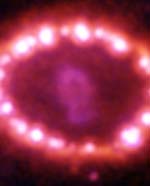
Image credit: Hubble
Seventeen years ago, astronomers spotted the brightest stellar explosion ever seen since the one observed by Johannes Kepler 400 years ago. Called SN 1987A, the titanic supernova explosion blazed with the power of 100,000,000 suns for several months following its discovery on Feb. 23, 1987. Although the supernova itself is now a million times fainter than 17 years ago, a new light show in the space surrounding it is just beginning.
This image, taken Nov. 28, 2003 by the Advanced Camera for Surveys aboard NASA’s Hubble Space Telescope, shows many bright spots along a ring of gas, like pearls on a necklace. These cosmic “pearls” are being produced as a supersonic shock wave unleashed during the explosion slams into the ring at more than a million miles per hour. The collision is heating the gas ring, causing its innermost regions to glow.
Astronomers detected the first “hot spot” in 1996, but now they see dozens of them all around the ring. The temperature of the flares surges from a few thousand degrees to a million degrees Fahrenheit. Individual hot spots cannot be seen from ground-based telescopes. Only Hubble can resolve them.
And, more hot spots are coming. In the next few years, the entire ring will be ablaze as it absorbs the full force of the crash. The glowing ring is expected to become bright enough to illuminate the star’s surroundings, thus providing astronomers with new information on how the star ejected material before the explosion.
The elongated and expanding object in the middle of the ring is debris from the supernova blast. The glowing debris is being heated by radioactive elements, principally titanium 44, that were created in the supernova explosion. The debris will continue to glow for many decades.
The ring, about a light-year across, already existed when the star exploded. Astronomers believe the star shed the ring about 20,000 years before the supernova blast.
The violent death of a star 20 times more massive than the Sun, called a supernova, created this stellar drama. The star actually exploded about 160,000 years ago, but it has taken that long for its light to reach Earth. The supernova resides in the Large Magellanic Cloud, a nearby small galaxy that is a satellite or our Milky Way galaxy.
Since its launch in 1990, the Hubble telescope has watched the supernova drama unfold, taking periodic snapshots of the gradually fading ring. Now, the orbiting observatory will continue to monitor the ring as it brightens from this collision.
Original Source: Hubble Space Telescope
